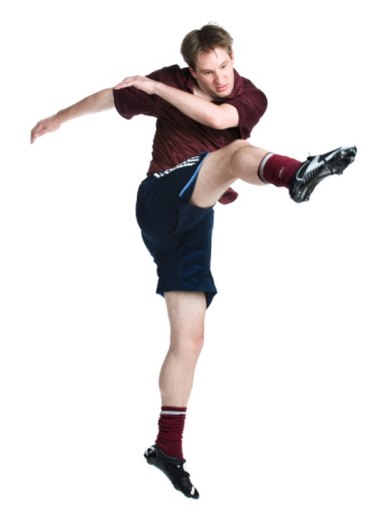
Soccer is an intense sport that requires the athletes to be active for 90 minutes, covering distances up to 7 miles while playing on the field, according to Dr. Howard Liebeskind the United States national soccer team's podiatrist. In order to remain fit enough to complete this challenging task, many soccer teams have specialized fitness programs that focus on strengthening and conditioning the muscle groups most often used in soccer. A recent report by the Center of Research, Education, Innovation and Intervention in Sport demonstrated that during the preseason, youth soccer athletes sustain injuries at a rate of 7.2 percent of which 79 percent involve the lower limbs, 23 percent that were specific to the thigh. A similar study focusing on professional players conducted at the Department of Medical and Health Sciences found that 92 percent of all muscle injuries were to the muscles groups of leg and lower leg at a rate of 37 percent for hamstrings, 23 percent for adductors, 19 percent for quadriceps and 13 percent calf muscles.
Arm
Video of the Day
Arm musculature is an important part of the overall strength of a soccer player. Developed biceps, triceps and shoulders will help increase a player's stature that is useful when shielding the ball. These muscles act to balance a player as they jump, head a ball and run. With the exception of the goalkeeper, players are unable to use their hands to play with the ball unless doing a throw-in after a ball travels out of bounds. Developed arm muscles allow players to be able to complete a powerful and accurate throw-in, which can be a valuable asset to create goal-scoring opportunities when you are within 20 or so yards of the goal line.
Video of the Day
Core
The core muscles consist of the area from under your chest to the start of the pelvic region. As the muscle group suggests, the core muscles are the primary support of the body and include the muscles of the abdomen and back. By developing this area, players can improve their balance and overall stamina. Additionally, a study conducted at the University of Delaware demonstrated that the development of core stability decreases the rates of back and lower extremity injury.
Thigh
The muscles of the thigh include three muscle groups: the anterior, posterior and adductors. The most notable of these muscle groups are the anterior muscles that consist of the four muscles that make up the quadriceps and the posterior muscles that contain the hamstring. These muscles are the powerhouse of the body and provide short bursts of energy to allow players to sprint or maintain a steady jog while playing. Developing these muscles will make a player faster, as well as give more power for kicking.
Leg
Anatomically, the leg muscles are the muscles that go from below the knee to the ankle. This muscle group supports the vital knee and ankle joints and allows soccer players to sprint, cut quickly and control the muscles of the foot. The gastrocnemius, or the calf muscle, is the most prominent muscle of the lower leg. The two heads of this muscle join together to form an attachment to the heel commonly known as the Achilles tendon and is a common site of injury. It is important for players to develop this muscle group to balance out the powerful muscles of the thigh.
- “Clinical Journal of Sports Medicine”; Injuries in Youth Soccer During the Preseason; J Brito, et al.; May 2011
- “American Journal of Sports Medicine”; Epidemiology of Muscle Injuries in Professional Football (Soccer); Jan Ekstrand, et al.; June 2011
- Soccer Training Guide: Soccer Weight Training
- “Journal of the American Academy of Orthopedic Surgery”; Core Stability and Its Relationship to Lower Extremity Function and Injury; JD Willson, et al.; September 2005